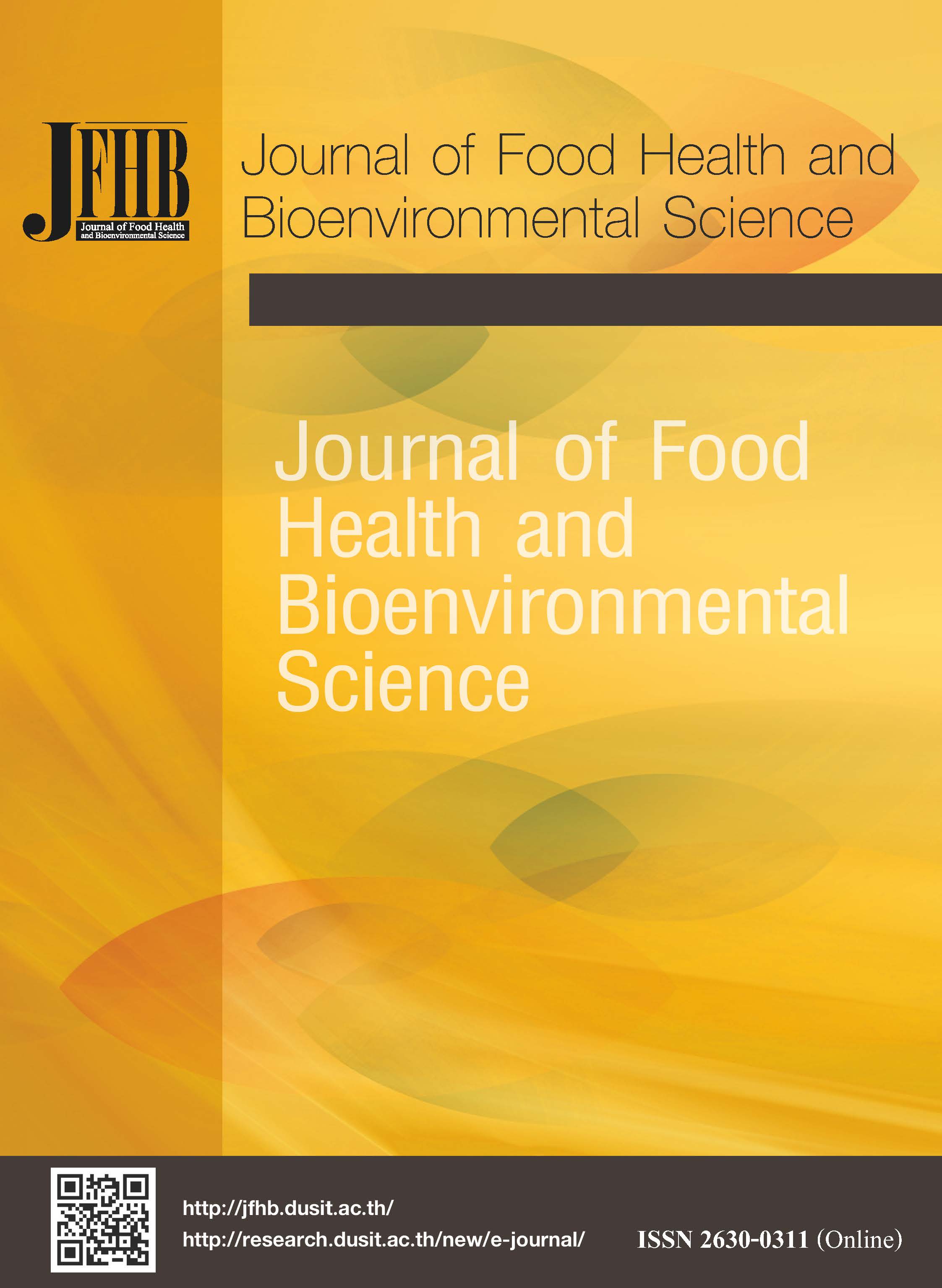Purple Sweet Potato Soft Bun as a Value-adding of Local Agricultural Production
Keywords:
soft bun, purple sweet potato, shelf-life, nutritional valueAbstract
The research was undertaken to study the appropriate substituting level of purple sweet potato (PSP) flour for bread flour in making soft buns. Soft buns with 0-50% PSP flour substituting for bread flour were prepared. Prepared soft buns were
visually observed and tests were performed to determined pH, moisture, color, firmness and springiness. A hedonic test was conducted with 30 untrained panelists in order to select the suitable level of PSP flour substitution. The original soft bun and the suitable PSP flour substituted soft bun were compared regarding shelf-life and nutritional values. When PSP flour substitutions were increased from 0 to 50%, visual observation of prepared soft buns showed size decreasing, crust color changed from light golden brown to dark purplish brown, crumb color changed from off white to dark purplish brown, texture was firmer, and springiness was lesser. The pH of the soft buns was 5.47 – 5.65, which were not significantly different. The moisture contents of the soft buns with 10 -50 % PSP flour substitution, 25.03-26.35 %, were significantly different and slightly higher than 24.49 % of the control sample (0% PSP flour substitution). The hedonic test showed that 30 % PSP flour substituted soft bun had the highest score (8.16) on overall liking. Therefore, it was selected as an appropriate soft bun for further study. The shelf-life of the control and 30% PSP flour substituted soft buns strored in polyvinylidenechloride (PVDC) bags with oxygen absorber, resulted in 3 days at room temperature (25 °C) and 7 days at refrigerator temperature (4 °C). Soft bun at 30 % PSP flour substitution had a noticeable increase in vitamin A (from 981.0 to 3105 µg), carotene (from 0.7 to 13.4 mg), vitamin E (from 5.5 to 11.9 mg) and potassium (from 520.4 to1093.4 mg) compared to original one. Commercial PSP soft bun production with 30% PSP flour substitution for bread flour could add value for the local agricultural produce.
References
AOAC. (2000). Official methods of analysis of AOAC international (17th ed.). Maryland, USA.: Gaithersburg. Charoenphan, N. (2018). Product development of cookies from sweet potatoes. Journal of Food Technology Siam University. 13(1), 32-43.
Chompreeda, P. (2006). Sensory evaluation and consumer acceptance. Bangkok: Vista Inter Print.
Grace, M., Yousef, G., Gustafson, S., Truong, V., Yencho, G., & Lila, M. (2014). Phytochemical changes in phenolics, anthocyanins, ascorbic acid, and carotenoids are associated with sweet potato storage and impact bioactive properties. Journal Food Chemistry, 145, 724 – 717.
Hongpan, N., Chainarong, K., & Kalawong. S. (2021). Study of partial substitution levels of wheat flour with purple sweet potato puree on qualities of brownies. Sciencs Burapha Journal, 26(3), 1745-1761.
Jammak, J. & Naivikul, O. (2017). Basic baking science and technology. Bangkok: Kasetsart University Press.
Jang, H., Kim, H., Kim, S., Kim, S., Kim, J., & Lee, Y. (2019). In vitro and in vivo hypoglycemic effects of cyaniding 3-caffeoyl phydroxybenzoylsophoroside-5-glucoside, an anthocyanin isolated from purple-fleshed sweet potato. Journal Food Chemistry, 272, 688 - 693.
Lazzè, M.C., Savio, M., Pizzala, R., Cazzalini, O., Perucca, P., Scovassi, A.I., ... Bianchi, L. (2004). Anthocyanins induce cell cycle perturbations and apoptosis in different human cell lines. Carcinogenesis, 25(8), 1427-1433.
Limrungruangrat, K. (2004). Potential uses of sweet potato in food industry. Sciencs Burapha Journal, 9, 81-93.
López, A.C.B., Pereira, A.J.G., & Junqueira, R.G. (2004). Flour mixture of rice flour, corn and cassava starch in the production of gluten-free white bread. Brazilian Archives of Biology And Technology, 47, 63-70.
Mongkolthanawat, N., & Bunna, S. (2023) Physicochemical and sensory characteristics of daifuku products made from native black glutinous rice in chanthaburi province. Journal of Science and Technology Kasetsart University, 12(1), 58-70.
Moore, S. (2023). Why is moisture content analysis of food important, food analysis laboratory manual. USA: Azo Network.
Postharvest and Processing Research and development Division (2023). Sweet potato. Bangkok: Department of Agriculture.
Rattanapanone, N. (2006). Food science of fats and oils. Bangkok: Publisher Odean Store
Sandstedt, R. (1961). The function of starch in baking of bread. Baker's Digest, 35, 36-44.
Schober, T.J., O'brien, C.M., McCarthy, D., Darnedde, A., & Arendt, E.K. (2003). Influence of gluten-free flour mixes and fat powders on the quality of gluten-free biscuits. European Food Research and Technology, 216, 369-376.
Sroan, B., Bean, S., & MacRitchie, F. (2009). Mechanism of gas cell stabilization in bread making. I. The primary gluten–starch matrix. Journal of Cereal Science, 49, 32–40.
Woolfe, J. (1992) Sweetpotato: An untapped food resource. Cambridge: Cambridge University Press.
Zhu, F., & Sun, J. (2019). Physicochemical and sensory properties of steamed bread fortified with purple sweet potato flour. Food Bioscience, 30, 100411.
Downloads
Published
How to Cite
Issue
Section
License

This work is licensed under a Creative Commons Attribution-NonCommercial-NoDerivatives 4.0 International License.








